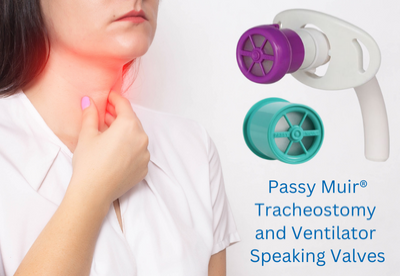-
Home
-
Benefits of Early In-Line Speaking Valve Use
Benefits of Early In-Line Speaking Valve Use
October 24, 2022

There are many researched benefits to early speaking valve placement. Respiratory therapists and speech-language pathologists are often the first to champion early implementation of speaking valves for its ability to improve respiration, communication, swallowing and overall patient well-being. Progressing patients from mechanical ventilation, however, requires collaborative support from a patient's full care team. Attending physicians, pulmonologists, nurses, physical therapists, and occupational therapists play a critical role in the patient's treatment process. In fact, formal interdisciplinary trach teams have been proven to decrease the length of hospital stay (LeBlanc et al., 2010), decrease time to decannulation, and lessen adverse events (Cetto et al., 2011). Understanding and educating your team on these benefits may help to reduce barriers to early placement.
Benefits
Respiratory
- Restores subglottic pressure, upper airway sensation and PEEP
- Improves alveolar recruitment to minimize atelectasis (Sutt et al, 2017)
- Increases gas exchange and improves saturation levels (O’Connor, Morris, & Paratz, 2018)
- Reduces time to ventilator weaning and tracheostomy tube decannulation
Communication
- Improves true vocal cord closure
- Improves verbal communication (Fröhlich et al., 2017)
Swallowing
- Improved swallow function, increases incidences of early oral diets and reduced risk of aspiration (Fröhlich et al., 2017; Welton et al. 2016; O’Connor et al, 2019)
- Restores smell and taste (O’Connor et al, 2019)
- Improves cough
Mind/Body
- Increases the patients’ confidence and motivation (Freeman-Sanderson et al., 2018)
- Improves quality of life.
- Decreases the need for sedating medications (Kinneally, 2018)
- Improves functional mobility (Ceron et al., 2020)
Selecting the Right Patient
Choosing whether a patient is appropriately suited for use of a speaking valve is a decision that should be discussed amongst your interdisciplinary team. Keep the following guidelines and considerations in mind when deciding whether or not a patient would benefit from the use of a speaking valve.
Patient Selection & Guidelines
- Patient is awake and medically stable
- Patient can tolerate 100% cuff deflation
- Secretions can be managed with closed system suction
- Appropriately sized trach tube and patent upper airway
- A water or air cuff (foam cuffs are contraindicated)
- 72 hours post tracheotomy
- FiO2 less than .60
- PEEP less than 10cm H2O
- PIP less than 40cm H2O
Troubleshooting
If the patient demonstrates an inability to safely utilize the speaking valve, troubleshooting should be initiated and discussed with the interdisciplinary team.
Questions to Consider
- Is the trach too big?
- Are there too many secretions?
- Is the patient too sick?
- Is the airway patent?
- Is the patient anxious?
Enhancing Treatment with Respiratory Muscle Training
Once a patient is safely tolerating a speaking valve, expiratory muscle training can be an effective treatment to help reduce respiratory muscle weakness, facilitate weaning, increase vocal intensity, and even improve swallowing function.
Passy Muir® Tracheostomy and Ventilator Speaking Valves - patented bias-closed position, no-leak design redirects airflow through the vocal folds, mouth, and nose, enabling voice and improved communication while helping restore natural positive airway pressure.
Authored by: Jennifer Llado, MS, MS, CCC-SLP
References
Ceron, C., Otto D., Signorini, A. V., Beck, M. C., Camilis, M., Sganzerla, D., Rosa, R. G., & Teixeria, C. (2020). The effect of speaking valves on ICU mobility of individuals with tracheostomy. Respiratory Care, 65(2), 144–149. https://doi.org/10.4187/respcare.06768
Cetto, R., Arora, A., Hettige, R., Nel, M., Benjamin, L., Gomez, C. M., Oldfield, W. L., & Narula, A. A. (2011). Improving tracheostomy care: A prospective study of the multidisciplinary approach. Clinical Otolaryngology, 36(5), 482–488. https://doi.org/10.1111/j.1749-4486.2011.02379.x
Freeman-Sanderson, A. L., Togher, L., Elkins, M. R., & Kenny, B. (2018). Quality of life improves for tracheostomy patients with return of voice: A mixed methods evaluation of the patient experience across the care continuum. Intensive Critical Care Nursing, 46:10-16. doi:10.1016/j. iccn.2018.02.004
Fröhlich, M. R., Boksberger, H., Barfuss-Schneider, C., Liem, E., & Petry, H. (2017). Safe swallowing and communicating for ventilated intensive care patients with tracheostoma: Implementation of the Passy Muir speaking valve. Pflege, 30(6), 87-394. https://doi.org/10.1024/1012-5302/a000589
Kinneally, T. (2018). Do speaking valves reduce sedative drug use in ICU? A retrospective data analysis. Australian Critical Care, 31(2), 131–132.
LeBlanc, J., Shultz, J. R., Seresova, A., de Guise, E., Lamoureux, J., Fong, N., Marcoux, J., Maleki, M., & Khwaja, K. (2010). Outcome in tracheostomized patients with severe traumatic brain injury following implementation of a specialized multidisciplinary tracheostomy team. The Journal of Head Trauma Rehabilitation, 25(5), 362–365. https://doi.org/10.1097/HTR.0b013e3181cd67ea
O’Connor, L. R., Morris, N. R., & Paratz, J. (2019). Physiological and clinical outcomes associated with use of one-way speaking valves on tracheostomised patients: A systematic review. Heart & Lung, 48(4), 356- 364. doi:10.1016/j.hrtlng.2018.11.006
Sutt, A. L., Antsey, C., Caruana, L. R., Cornwell, P. L., & Fraser, J. (2017). Ventilation distribution and lung recruitment with speaking valve use in tracheostomised patient weaning from mechanical ventilation in intensive care. Journal of Critical Care, 40:164-170. doi:10.1016/j.jcrc.2017.04.001
Welton, C., Morrison, M., Catalig, M., Chris, J., & Pataki, J. (2016). Can an interprofessional tracheostomy team improve weaning to decannulation times? A quality improvement evaluation. Canadian Journal of Respiratory Therapy, 52(1), 7-11.